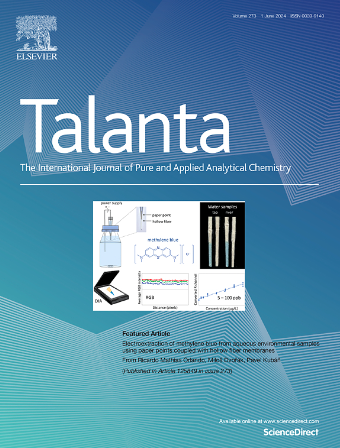Live bacteria detection with high specificity by utilizing Eu3+@MIL-53 (Al) and bacteriophages-based fluorescence biosensor
IF 5.6
1区 化学
Q1 CHEMISTRY, ANALYTICAL
引用次数: 0
Abstract
Pseudomonas aeruginosa (PA) infection poses a significant threat to human health and the economy, with the issue of drug resistance becoming increasingly severe. How to quickly, accurately, and inexpensively detect PA and differentiate live bacteria from dead ones is crucial for clinical follow-up treatment. To this end, we have developed a biosensor based on fluorescent metal-organic frameworks (MOFs) (Eu3+@MIL-53(Al)) and specific-phages for PA detection, where the Eu3+@MIL-53(Al) prepared by one-pot method exhibits excellent fluorescence properties. By covalently binding specific phages isolated from hospital wastewater to the EuMOF surface, we constructed a fluorescent biosensor capable of detecting PA within 15 min, with a sensitivity threshold of 2 CFU/mL. Notably, this biosensor demonstrates high specificity, accurately quantifying live PA in complex bacterial mixtures and distinguishing live from dead bacteria. Its practical application has been validated in clinical blood and stool samples. As a novel platform for clinical microbial monitoring, the Eu3+@MIL-53(Al)-phage biosensor not only holds substantial economic potential but also carries significant public health implications.

求助全文
约1分钟内获得全文
求助全文
来源期刊

Talanta
化学-分析化学
CiteScore
12.30
自引率
4.90%
发文量
861
审稿时长
29 days
期刊介绍:
Talanta provides a forum for the publication of original research papers, short communications, and critical reviews in all branches of pure and applied analytical chemistry. Papers are evaluated based on established guidelines, including the fundamental nature of the study, scientific novelty, substantial improvement or advantage over existing technology or methods, and demonstrated analytical applicability. Original research papers on fundamental studies, and on novel sensor and instrumentation developments, are encouraged. Novel or improved applications in areas such as clinical and biological chemistry, environmental analysis, geochemistry, materials science and engineering, and analytical platforms for omics development are welcome.
Analytical performance of methods should be determined, including interference and matrix effects, and methods should be validated by comparison with a standard method, or analysis of a certified reference material. Simple spiking recoveries may not be sufficient. The developed method should especially comprise information on selectivity, sensitivity, detection limits, accuracy, and reliability. However, applying official validation or robustness studies to a routine method or technique does not necessarily constitute novelty. Proper statistical treatment of the data should be provided. Relevant literature should be cited, including related publications by the authors, and authors should discuss how their proposed methodology compares with previously reported methods.
 求助内容:
求助内容: 应助结果提醒方式:
应助结果提醒方式:


